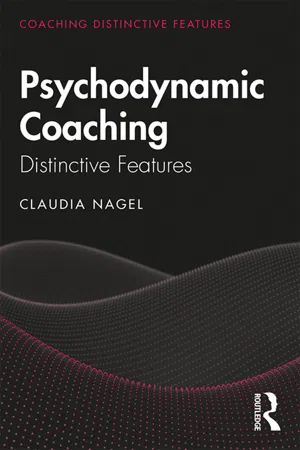The psychodynamic approach to coaching incorporates an array of psychoanalytical insights, techniques and interventions focussing on the unconscious and its influences on human behaviour. As its name implies, psychodynamic coaching has two components – first, it places the approach in a psychodynamic context, and second, it clarifies the grounds upon which psychodynamic thinking and techniques are applied.
A short historical overview of the roots of psychoanalytic thought1
Freud’s (1911) drive theory proposed that neurotic conflict lay between two different emotions or between an instinctual wish and a moral imperative, causing psychopathological reactions. Later, within his structural model, he developed the idea of conflicts and dynamics between the three instances of the mind: the Ego, the Id and the Superego (Freud, 1923). Conflicts can also develop out of dialectical tensions human beings are born into, particularly the fundamental human tension of autonomy versus attachment (Mentzos, 2009) (see Chapter 7). The choice of which to adhere to in a specific situation creates conflict and thus anxiety, yet at the same time fosters individual personality development. This consequently leads to renewal, dynamics, differentiation and progress, which C.G. Jung coined the individuation process. Jung founded his own school of analytical psychology, developing the notion of complexes, archetypes and the Self. Conflict here can appear within or between complexes on an intra- and inter-individual level and give rise to neurosis that may be addressed with the support of the transcendent function (Jung, 1959).
The development of psychodynamics then embraced the ego psychology first developed by Freud’s daughter, Anna Freud, who contributed the theory of ego defences dealing with inner-conflict and warding off the resulting anxiety (Freud, 1936). In conflict-based psychodynamic theory, anxiety and fear resulting from or underlying conflicting choices are considered as the main driver of unconscious reaction. This is recognised as one of the major strands in psychoanalytic theory building and psychotherapy (Mentzos, 2009).
Around the same time, relations came into play with Melanie Klein (1882–1960), the first child psychoanalyst of the object-relations school. She understood the phantasised mother-child relationship as central to personality development. In contrast, Winnicott (1896–1971), the founder of the British object relation school, focussed on the real mother-child relationship and introduced the term “good enough mother” (1954), referring to the concept of the transitional object and the transitional space at the beginning of life. This is the intermediary space between mother and child, where they meet on a conscious and unconscious level and the child tries and tests fantasy and reality. The transitional object serves as a bridge between inner- and outer-reality. Later in adult life this transitional space develops into the basis for play and creativity.
Based on infant research, Bowlby (1907–1990) together with Mary Ainsworth (1913–1999) pioneered attachment theory. Ainsworth’s focus was the infant’s need for a safe base for developing secure attachment. Bowlby defined attachment more broadly as “the capacity to make intimate emotional bonds between people” (Bowlby, 1998), an innate psycho-biological drive to seek proximity with a familiar person (caregiver in infancy) when under threat. He also developed the notion of internal working models: basic models for relating with attachment figures that a child forms over time and which consequently influence all social relationships.
Bion (1897–1979) also significantly influenced psychodynamic theory with his model of the mother-child relationship, which presents the mother as the container and the child the contained. This theory suggests that unbearable states of mind are digested and psychically fed back to the child – the child perceives them and experiences them as a first form of thought (1962).
Bion is also of special interest in the work-oriented coaching context, as he has developed theoretical concepts around group dynamics and unconscious processes in working groups.
Contemporary psychodynamics is also informed by neuroscience, particularly neuropsychoanalysis. One of the founding fathers is Mark Solms building on the work of Peter Fonagy, Jaap Panksepp and Oliver Turnbull. One aim of psychodynamic neuroscience is to ascribe to mental processes an ontological status that is as real as that of neural processes. Neuroscience shares a fundamental aspiration with Freudian metapsychology, that is, to generate an accurate, large-scale model of the mind (Fotopoulou, 2012).
In summary, psychodynamic coaching focusses on the inner-world of the client in the context of leadership roles within organisations. It strives to connect the inner- and outer-worlds so that the outer-world, with its relationships and institutions, can be seen realistically by understanding and modifying individually influencing biases, blind spots, distortions and emotional reactions. The purpose is personal growth and development, to be in touch with one’s own feelings and to become more emotionally intelligent. The approach works on the capacity to reflect on one’s own emotions and the reactions and relationships that lead to them, to assess their role in the present situation and determine how to best handle them.
This work requires a systems perspective also – since the outer organisational world is continuously influencing the individual and their perceptions and behaviours. Psychodynamic coaching, hence, is often referred to as systems-psychodynamic coaching (Brunning, 2006) using the Person–Role–System model to investigate the relations, boundaries and influences between these three spheres from a psychodynamic perspective.
Although psychodynamics in coaching is rooted in psychoanalytical thinking, it is not to be misunderstood as psychotherapy. It is a psychologically informed developmental process, not a treatment for psychopathologies or emotional disturbances.
